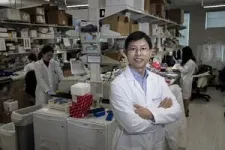(Press-News.org) FINDINGS
Scientists at City of Hope, one of the largest cancer research and treatment organizations in the United States, have identified how low levels of the TET2 gene fuel the rapid growth of acute myeloid leukemia in animal models. Cell Stem Cell recently published the study.
A team led by Jianjun Chen, Ph.D., the Simms/Mann Family Foundation Chair in Systems Biology at Beckman Research Institute of City of Hope, found that TET2 deficiency sets off a cascade of biochemical changes that enhance the bone marrow cancer’s ability to spread. These changes include:
Driving the movement of malignant stem cells from the bloodstream to the bone marrow region where they originated. This home microenvironment, called a niche, protects the cells’ survival and ability to divide and self-replicate.
Increasing the expression of a protein called TSPAN13 that signals leukemia stem cells to travel back to the bone marrow niche
Leading to the buildup of a methylated form of the RNA base cytosine that enhances TSPAN13 messenger RNA’s stability, resulting in the increased expression of TSPAN13 protein
Activating a signaling pathway called the TSPAN13/CXCR4 axis that increases malignant stem cells’ return (i.e., homing) to the bone marrow niche and self-replication, thereby leading to the rapid development of leukemia.
SIGNIFICANCE
By expanding understanding of the multiple ways that TET2 influences the development of acute myeloid leukemia, the discovery points to new potential therapeutic targets for treating the disease.
“This study provides novel insights into the cellular and molecular mechanisms underlying the development of acute myeloid leukemia,” Chen said. “Our findings highlight the therapeutic potential of reactivating TET2 signaling in patients with TET2 mutations or transcriptional suppression. Equally exciting, this strategy could be applied to other types of cancer that feature TET2 deficiency.”
BACKGROUND
Acute myeloid leukemia is distinguished by the rapid division and spread of immature leukemia stem cells. More than half of patients relapse, and the five-year survival rate is only 30%. Figuring out how to destroy these cells is crucial to effectively treating the disease.
TET2 deficiency cooperates with leukemia-related oncoproteins resulting from chromosomal abnormalities or gene mutations to drive the development of leukemia and enhance malignant stem cells’ ability to divide and spread. Until now, however, the cellular and molecular mechanisms underlying these processes have remained murky.
In analyzing data from the Cancer Genome Atlas, Chen and his colleagues found that lower expression or mutation of TET2 was associated with a poor prognosis and shorter overall survival rates for patients. Compared to healthy control subjects, TET2 expression was significantly suppressed in acute myeloid leukemia patients. This led the team to investigate the clinical relevance of TET2 in the development of the disease.
FUNDING
The research was partly supported by grants from the National Institutes of Health (R01 CA214965, R01 CA243386, R01 CA236399, R01 CA271497, R01 DK124116 and R01 CA280389), the Simms/Mann Family Foundation, Leukemia Research Foundation New Investigator Research Grant, The Margaret E. Early Medical Research Trust, and the American Association for the Study of Liver Diseases Foundation (PNC22-261362 and T32 CA186895).
# # #
About City of Hope
City of Hope's mission is to deliver the cures of tomorrow to the people who need them today. Founded in 1913, City of Hope has grown into one of the largest cancer research and treatment organizations in the U.S. and one of the leading research centers for diabetes and other life-threatening illnesses. City of Hope research has been the basis for numerous breakthrough cancer medicines, as well as human synthetic insulin and monoclonal antibodies. With an independent, National Cancer Institute-designated comprehensive cancer center at its core, City of Hope brings a uniquely integrated model to patients spanning cancer care, research and development, academics and training, and innovation initiatives. City of Hope’s growing national system includes its Los Angeles campus, a network of clinical care locations across Southern California, a new cancer center in Orange County, California, and treatment facilities in Atlanta, Chicago and Phoenix. City of Hope’s affiliated group of organizations includes Translational Genomics Research Institute and AccessHopeTM. For more information about City of Hope, follow us on Facebook, X ( the platform formerly known as Twitter), YouTube, Instagram and LinkedIn.
END
The U.S. Department of Energy’s Argonne National Laboratory has named Sean Jones as deputy laboratory director for science and technology. Jones will begin his new role on October 9, serving as Argonne’s senior science strategist, advisor and chief research officer.
Jones will join Argonne from the National Science Foundation (NSF). In his current role as Assistant Director of the NSF’s Mathematical and Physical Sciences directorate, he oversees a $1.86 billion portfolio that includes five science divisions, domestic and international research facilities, and ...
Julie Carrier, professor and head of the University of Tennessee Department of Biosystems Engineering and Soil Science, was awarded the James R. and Karen A. Gilley Academic Leadership Award during the annual international meeting of the American Society of Agricultural and Biological Engineers (ASABE) in July.
The award was given in recognition of Carrier’s exceptional leadership as department head as well as her ongoing dedication to furthering the UT Institute of Agriculture’s mission to provide research and extension ...
PITTSBURGH, Aug. 17, 2023 – Patients with cancer who live in rural Pennsylvania counties appear to know that they may have better outcomes if they receive their cancer surgery at a hospital that performs a high volume of those surgeries, but still opt for lower volume hospitals closer to home when their cancer is likely less complex, according to a new analysis published today in JCO Oncology Practice by health policy scientists at the University of Pittsburgh School of Public Health.
With a shortage of experienced surgeons in rural America and rural ...
Gut microbiome variation associated with race and ethnicity arises after three months of age and persists through childhood, according to a new study published August 17th in the open access journal PLOS Biology by Elizabeth K. Mallott of Washington University in St. Louis, US, Seth Bordenstein of Pennsylvania State University, US, and colleagues.
Human microbiome variation has been linked to the incidence, prevalence and mortality of many diseases and is known to associate with race and ethnicity in the United States. However, in this context race and ethnicity are considered proxies for inequitable exposure to social and environmental determinants of health due to structural racism. ...
Environmental regulators and other organizations should do more scientific experimentation to inform natural resource policy, according to an international group of economists that includes University of Wyoming researchers.
In a new paper in the prestigious journal Science, the economists say more frequent use of up-front experiments would result in more effective environmental policymaking in areas ranging from pollution control to timber harvesting across the world.
“Although formal experimentation is a cornerstone of science and is increasingly embedded in nonenvironmental social programs, it is virtually absent in environmental ...
The city of Gatineau is planning a tramway network that will link up with Ottawa, where the Light Rail Transit (LRT) continues to be bogged down by major mishaps. With Montreal’s new Réseau express métropolitain (REM) light transit system experiencing its own hiccups to start, how can cities looking to incorporate mass transport systems successfully launch such endeavors while avoiding project failures and years of misfortune?
New research from a University of Ottawa professor suggests project leaders not overlook the “F” word.
Telfer School of Management professor Lavagnon Ika found a lack of full appreciation ...
Almost 66 million years ago, an asteroid struck the Earth, killing all non-avian dinosaurs and allowing mammals to dominate.
But just how did we evolve from rat-like creatures running between the feet of dinosaurs to take over their ecological niches? Dr. Kendra Chritz, assistant professor in the UBC department of earth, ocean and atmospheric sciences, aims to find out.
Dr. Chritz is co-leading a new multi-million-dollar research project to learn how ecosystems and organisms recover after a catastrophic, climate-changing event. She explains in this Q&A that clues may lie in the fossilized teeth of mammals.
Why don’t we know much about how mammals ...
Scientists have discovered an additional potential cause of the genetic mutations that result in rare conditions such as Huntington’s disease (HD).
The neurodegenerative diseases, which also include most spinocerebellar ataxias (SCAs), are known to be caused by an expansion in the CAG (cytosine-adenine-guanine) repeats within a gene that in turn leads to an expanded polyglutamine (polyQ) tract in a protein.
Such diseases are inherited, given that the expansion of CAG repeats in a gene can be passed down the generations.
Previously, it had been thought the damage in these genetic diseases was caused solely by increased protein aggregate toxicity.
However, ...
ITHACA, N.Y. -- Current methods can vastly overestimate the rates that malaria parasites are multiplying in an infected person’s blood, which has important implications for determining how harmful they could be to a host, according to a new report.
The findings also have consequences for understanding the evolution of traits that lead to drug resistance, how quickly a parasite might spread through a population, and for evaluating the effectiveness of new vaccines.
The study, “Extraordinary Parasite Multiplication Rates in ...
Female Genital Mutilation (FGM) is a leading cause of death in the countries where it is practised, with over 44,000 additional women and young girls dying each year, a new study reveals.
FGM accounts for more deaths in these countries than any cause other than enteric infections – usually resulting from consuming contaminated food or water – respiratory infections, or malaria and remains legal in five of the 28 countries where it is most practiced.
Researchers are calling for FGM to be made illegal Mali, Malawi, Chad, Sierra Leone, and Liberia, given that legal change can lead to cultural change. They also say that efforts must be ...





